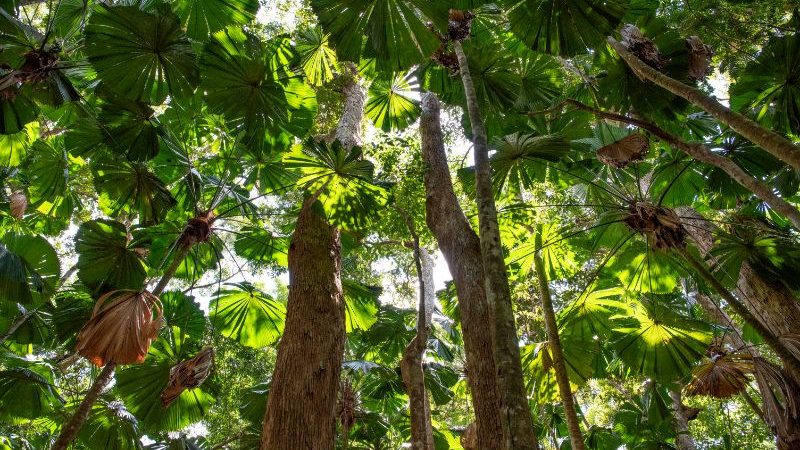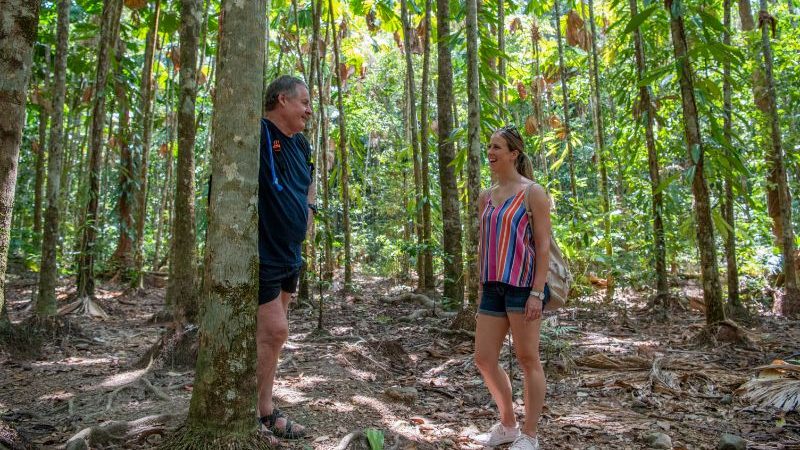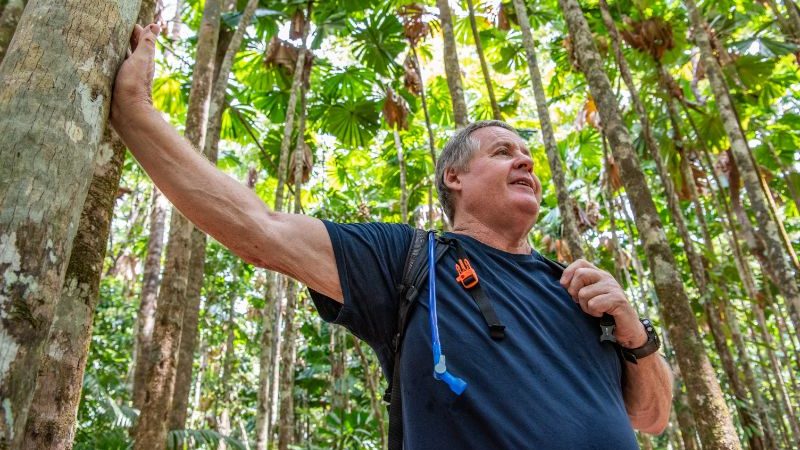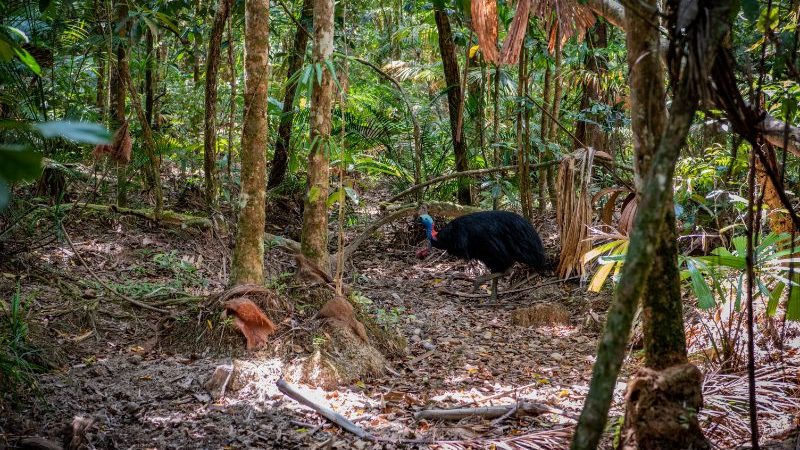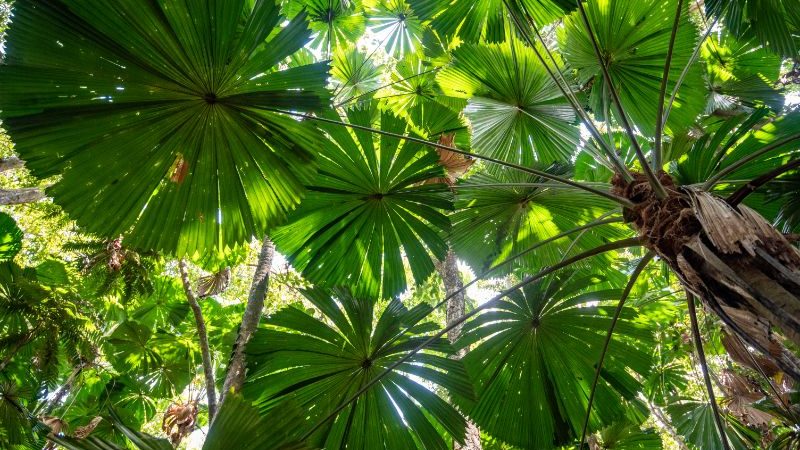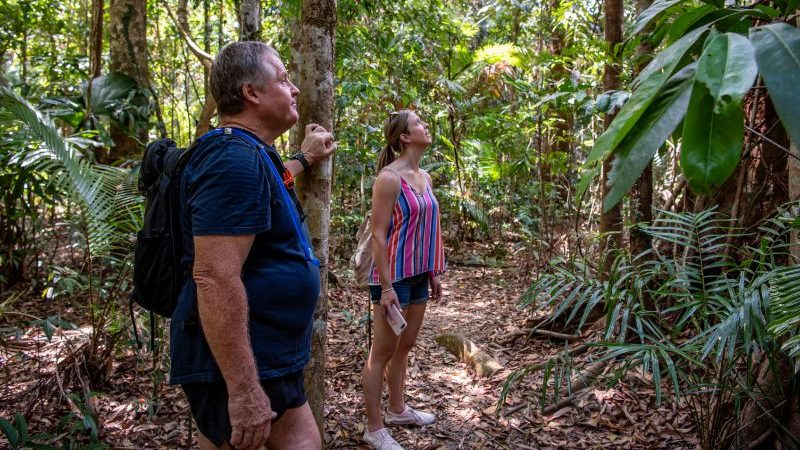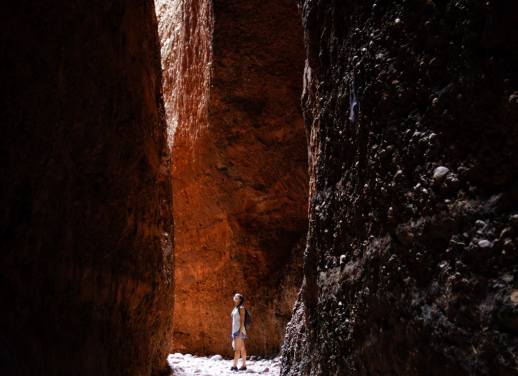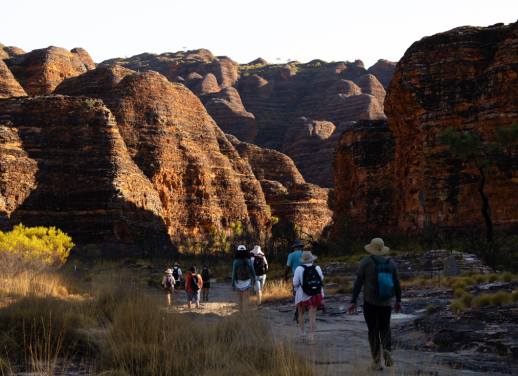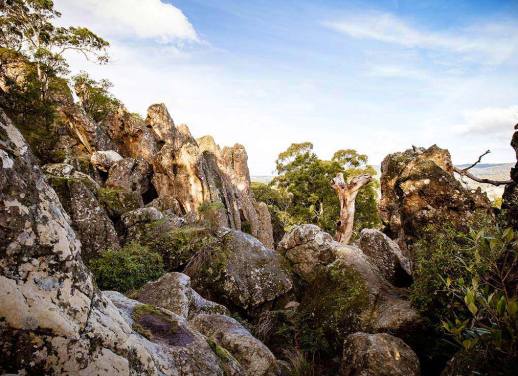“I’ve been studying the Daintree Rainforest for decades by living in it – it’s a fascinating place to be, inexhaustibly complex. I will never understand it all, which is a nice dilemma to have.”
Neil Hewitt is a unique man. Originally from Victoria in southern Australia, he and his family have lived in the Daintree for roughly thirty years on the World Heritage-listed property that he owns, Cooper Creek Wilderness.
“This is the only World Heritage property in Australia that isn’t government-funded and is privately owned,” says Neil as he leads us over a fallen fern and deeper into the forest.
We are on Intrepid’s 5-day Daintree Retreat and will be spending the morning exploring the heart of the rainforest on foot with Neil.
“We started running guided walks on the property to cover the costs associated with being World Heritage that are normally covered by the government,” says Neil, “so travellers that visit our property are paying the full cost of their experience and practicing a genuine form of eco-tourism.”
Tourism in the Daintree has a complicated history. In 1988, the Queensland government ceased logging the rainforest and directed the local timber industry to adjust their values and consider tourism as a viable source of income.
VISIT THE DAINTREE ON INTREPID TRAVEL’S 5-DAY DAINTREE RETREAT
The newly formed industry took off with such rapid success that the government quickly realised they needed to redirect some travellers to other parts of Queensland. They did this by stretching the brand of the Daintree and re-gazetting a whole lot of other national parks in 1995 to be part of what they now call ‘Daintree National Park’.
According to Neil, this re-gazetting has made the notion of where the true Daintree starts and ends quite difficult to pinpoint.
“Some of the places now included in Daintree National Park are much more robust than these ancient rainforests, which need to be protected. A key thing that distinguishes Cooper Creek from any of the other Daintree tourism experiences on offer is that this site is in the middle of the last fragment of the oldest surviving rainforest in the world, the true Daintree, which is 180 million years old.”
READ MORE: 5 PLACES YOU DON’T WANT TO MISS IN FAR NORTH QUEENSLAND
Neil started his career as an outdoor educator. He was sent to work in a First Nations community in Northern Queensland straight out of university, an experience he describes as ‘incredibly fortuitous’.
“Aboriginal clientele are perfect for an outdoor education methodology – their competencies and their knowledge makes them just outstanding recipients of that alternate methodology,” explains Neil.
“This is why classrooms and curriculum that reinforce the need to relinquish Aboriginality really don’t work in my opinion, particularly in remote communities. I found along the way that it was really quite perverse that I was being paid for my expertise teaching Indigenous people about the outdoor environment, which they know a lot more about than I ever could. Really, I was being paid to be exposed to their tremendous body of knowledge and it captured my interest and took me to the most remote parts of the country, which are less likely to be damaged through the dalliances of time.”
The Kuku Yalanji people are the Traditional Owners of the Daintree. They inhabited it for close to 70,000 years before their forcible removal. While some Kuku Yalanji have now returned to the area, their involvement in land conservation often takes place through their involvement in government organisations, which Neil believes is problematic.
“This is not empowering the Kuku Yalanji people to look after the landscape, because there’s a lack of trust, even though they’re the ones that should be trusted most. They have 70,000 years of success in their favour and now they’re being asked to salvage 70,000 years of lost memory.
“When the Aboriginal people were removed and taken to reserves, they had been bound to their corresponding sections of landscape for 200 years short of 70,000 years and that is a tremendously long period to become familiar with an optimised land management.
“Outlawing language and ceremony was within the power of the superintendents of those reserves, and this is how much of the knowledge was lost. Humans are tremendously important for eco-systems, but they have to be part of the eco-system for generations to acquire the knowledge to do exactly what the landscape wants them to do,” says Neil.
READ MORE: TRAVELLING IN AUSTRALIA IS LIKE AN AROUND-THE-WORLD ADVENTURE. THIS IS WHY.
As we explore Cooper Creek today, Neil points out a few of the impacts that the removal of the Kuku Yalanji people has had on the environment. He pauses mid-sentence and holds out a hand, stopping us in our tracks. We stay still and silent while I inwardly pray that he hasn’t spotted one of the eight-metre long pythons that he mentioned in passing earlier.
“Look over there, a cassowary,” Neil whispers, pointing, as we try to silently scramble for cameras and avoid startling the giant bird as it struts through the scrub. Its electric blue head and bright red wattle make it easy to spot, despite the dappled light and green backdrop.
As the crunching footsteps die away, Neil explains to us that the dwindling population of the native cassowary birds, who have been around for over 50 million years, are a prime example of the current mismanagement of the environment.
“Cassowaries are important to this eco-system because they eat the fruit of certain native trees and then, through their droppings, transport the seeds of that fruit to other areas of the forest where they grow. Many of those fruits are toxic to every other bird and animal, so the cassowaries are the only transporters. For that reason, they are the most valuable and irreplaceable of the inhabitants in the forest.
“We have a terrible problem with introduced wild pigs in Australia and they take up so much resource that they have decimated the Daintree for cassowaries. There should be at least 5,000 cassowaries in this environment and no pigs, and but instead there are 1,000 cassowaries and 60,000 pigs,” says Neil, shaking his head.
As well as the changes caused by the removal of the Kuku Yalanji people, there are other factors impacting the overall health of the Daintree: namely, global warming.
Until last year, there had been no monsoonal rains in the area for eight years, which is highly unusual for the tropical climate. Then, suddenly, they received 145 millimetres (almost 6 inches) overnight, which caused two landslides on the nearby mountain, Thornton Peak.
Neil says that from his perspective, there is far more media attention on conserving the Great Barrier Reef than there is about protecting the Daintree – and this needs to change.
“Even though the reef is a global treasure and a World Heritage area in its own right, there’s nothing on the reef that isn’t well secured in other parts of the world. The Daintree is the most irreplaceable portion of the world in terms of flora and fauna that is found nowhere else. It’s collapsing before our eyes, and it’s frustrating nothing is being done and there’s no commentary towards it.”
As we continue our tour, Neil draws our attention to some beautifully shaped foliage above our heads.
“This is a mature Fan Palm, with a strangler,” he announces to the group, as he gestures to a thick vine woven around the palm.
“Fan Palms are the most valuable and irreplaceable of the three to four thousand species of plants in the Daintree, because they are the only one that forms a partnership with a strangler that is not injurious to the palm, but beneficial in tying the Fan Palm to the rest of the forest canopy. The function of the strangler vines is to lock the forest into structural integrity, which is hugely important in protecting against cyclones.”
READ MORE: TRAVELLING TO AUSTRALIA? HERE’S YOUR ULTIMATE PACKING GUIDE.
It isn’t just the plants in the forest that are part of the protection strategy. Strangler vines produce up to 50 million pieces of fruit per tree over their lifetime, much of which is irresistible to flying animals. The animals eat the fruit and drop the seeds, which land on and stick to the upper canopy of the forest. Those seeds then sprout into vines and grow from the top of the forest down, all helping to hold the forest canopy together.
“These magnificent Fan Palms grow so slowly. It takes them 100 years to grow one metre,” explains Neil.
“You can see the design contributes rather magnificently to catching filtered sunlight, rain or the seeds of stranglers – so everything ends up tied to everything else. And this interconnectivity helps shoulder the impacts of cyclones across the assemblage, so the trees remain upstanding and the dislodged leaf material is then converted by the sun. This helps the massive reproductive process in the forest of flowering and fruiting, and the rainforest inhabitants are replenished with every cyclone that occurs.”
While the vines’ stranglehold on the rainforest may sound alarming, it’s entirely beneficial, and the real struggle lies in the fight we’re losing against pests, like wild pigs, and climate change. There are tens of thousands of years of land management knowledge that has been lost as a result of the displacement of First Nations people, but with people like Neil sharing information, promoting conservation and working tirelessly to make amends for generations of wrongdoing, there’s still hope for World Heritage sites like the irreplaceable Daintree.
You can take a locally guided tour with Neil, on Intrepid Travel’s 5-day Daintree Retreat. Book your place today.
All images c/o Patrick O’Neill.
As an Australian-owned business, we acknowledge the Traditional Owners of Country throughout Australia and their continuing connection to land, waters and community. We pay our respects to them and their cultures, and to their Elders past, present and future.

